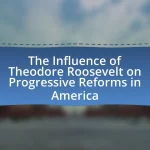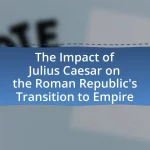Martin Luther King Jr. was a central figure in the Civil Rights Movement, advocating for nonviolent resistance against racial segregation and discrimination. His leadership in key events such as the Montgomery Bus Boycott and the March on Washington significantly influenced public opinion and led to landmark legislation, including the Civil Rights Act of 1964 and the Voting Rights Act of 1965. King’s philosophy of nonviolence, equality, and justice shaped civil rights activism and continues to resonate in contemporary movements, highlighting the ongoing struggle for racial equality and social justice in the United States. The article explores King’s impact on civil rights legislation, the principles guiding his activism, and the lasting legacy of his methods in modern advocacy efforts.
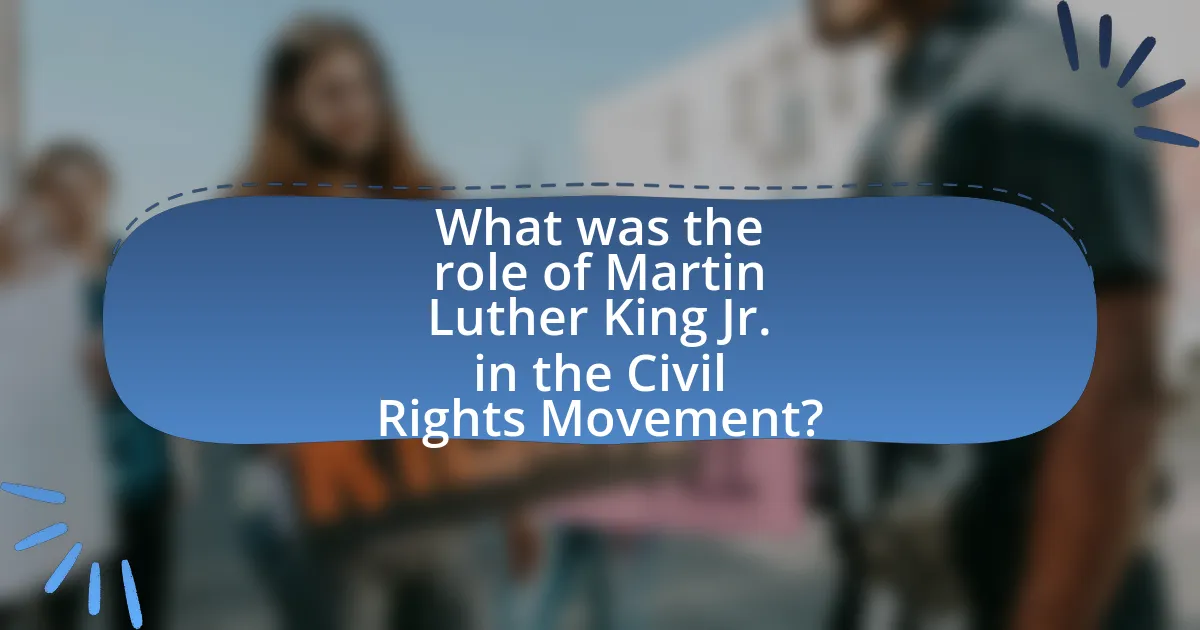
What was the role of Martin Luther King Jr. in the Civil Rights Movement?
Martin Luther King Jr. played a pivotal role in the Civil Rights Movement as a leader who advocated for nonviolent resistance to racial segregation and discrimination. He was instrumental in organizing key events, such as the Montgomery Bus Boycott in 1955 and the March on Washington in 1963, where he delivered his iconic “I Have a Dream” speech. King’s leadership and commitment to peaceful protest significantly influenced public opinion and legislative change, contributing to the passage of landmark legislation like the Civil Rights Act of 1964 and the Voting Rights Act of 1965. His efforts galvanized support for civil rights, making him a central figure in the movement and a symbol of the struggle for racial equality in the United States.
How did King’s philosophy influence civil rights activism?
King’s philosophy of nonviolent resistance significantly influenced civil rights activism by promoting peaceful protests and civil disobedience as effective means to achieve social change. His approach, rooted in the teachings of Mahatma Gandhi and Christian principles, encouraged activists to confront injustice without resorting to violence, which helped to garner public sympathy and support for the civil rights movement. For instance, during the Montgomery Bus Boycott in 1955, King’s leadership exemplified this philosophy, leading to a successful year-long protest that resulted in the desegregation of public buses. This method of nonviolent action became a cornerstone of civil rights activism, inspiring events such as the March on Washington in 1963, where King delivered his iconic “I Have a Dream” speech, further solidifying the movement’s moral high ground and urgency for legislative change.
What were the key principles of King’s philosophy?
The key principles of Martin Luther King Jr.’s philosophy included nonviolence, equality, and justice. Nonviolence was central to his approach, as he believed that peaceful protest was the most effective means to achieve social change, inspired by Mahatma Gandhi’s teachings. King emphasized equality, advocating for the civil rights of African Americans and all marginalized groups, asserting that everyone deserves equal treatment under the law. Justice was another crucial principle, as he argued that systemic injustices must be addressed to create a fair society. These principles were articulated in his speeches and writings, such as the “I Have a Dream” speech and his “Letter from Birmingham Jail,” where he outlined the moral imperative for civil rights activism.
How did these principles manifest in his activism?
Martin Luther King Jr.’s principles of nonviolence and equality manifested in his activism through organized peaceful protests, such as the Montgomery Bus Boycott and the March on Washington. These events exemplified his commitment to civil disobedience as a means to challenge racial segregation and advocate for civil rights. For instance, the Montgomery Bus Boycott, initiated in 1955, resulted in a Supreme Court ruling that declared segregation on public buses unconstitutional, demonstrating the effectiveness of his nonviolent approach. Additionally, during the March on Washington in 1963, King delivered his iconic “I Have a Dream” speech, which galvanized public support for the Civil Rights Act of 1964, further solidifying his influence on civil rights legislation in the U.S.
What were the major events led by Martin Luther King Jr.?
Martin Luther King Jr. led several major events that significantly impacted the Civil Rights Movement in the United States. Notable events include the Montgomery Bus Boycott in 1955, which protested racial segregation on public buses, and the March on Washington for Jobs and Freedom in 1963, where he delivered his iconic “I Have a Dream” speech advocating for racial equality. Additionally, King played a crucial role in the Selma to Montgomery marches in 1965, which highlighted the struggle for voting rights and contributed to the passage of the Voting Rights Act later that year. These events collectively advanced civil rights legislation and raised national awareness about racial injustices.
What was the significance of the Montgomery Bus Boycott?
The significance of the Montgomery Bus Boycott was its role as a pivotal event in the American civil rights movement, demonstrating the effectiveness of nonviolent protest against racial segregation. Initiated in December 1955 after Rosa Parks’ arrest, the boycott lasted for 381 days and resulted in a Supreme Court ruling that declared segregation on public buses unconstitutional. This landmark decision not only challenged systemic racism but also propelled Martin Luther King Jr. into a leadership position, establishing him as a key figure in advocating for civil rights legislation in the U.S. The boycott’s success inspired further activism and laid the groundwork for subsequent civil rights initiatives, highlighting the power of collective action and nonviolent resistance.
How did the March on Washington impact public perception?
The March on Washington significantly shifted public perception by bringing national attention to the civil rights movement and highlighting the demand for racial equality. This event, particularly marked by Martin Luther King Jr.’s “I Have a Dream” speech, galvanized support from diverse demographics, including white Americans who had previously been indifferent. The march, attended by over 250,000 people in 1963, showcased the unity and determination of civil rights activists, leading to increased media coverage and public discourse around issues of segregation and discrimination. As a result, it played a crucial role in influencing public opinion, which ultimately contributed to the passage of landmark legislation such as the Civil Rights Act of 1964 and the Voting Rights Act of 1965.
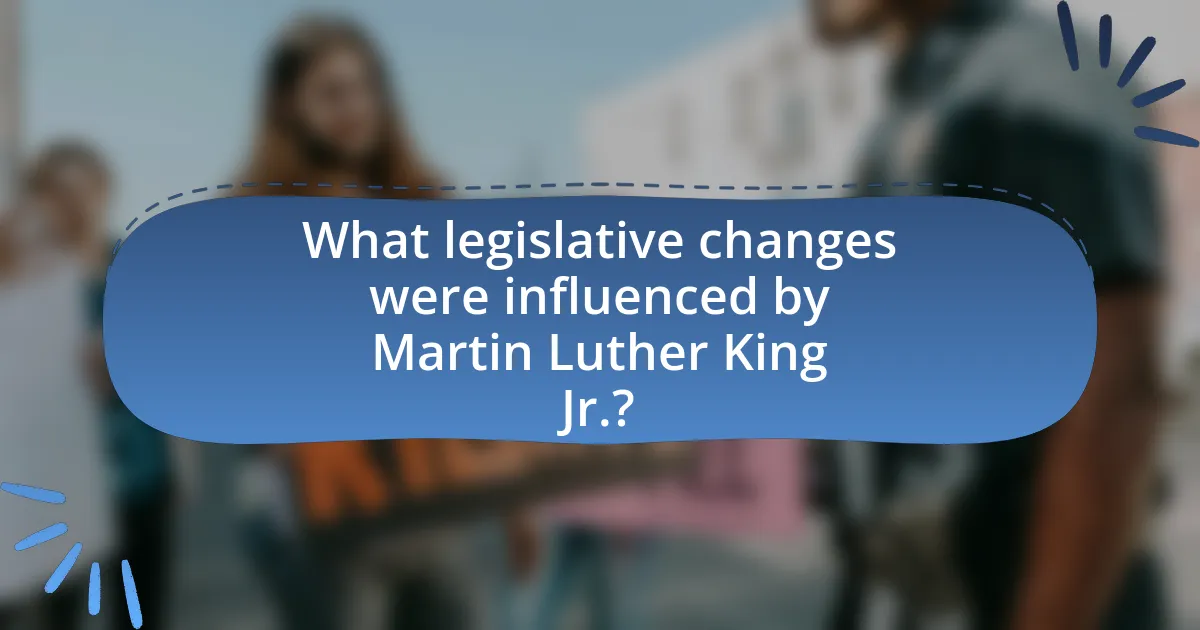
What legislative changes were influenced by Martin Luther King Jr.?
Martin Luther King Jr. significantly influenced the passage of the Civil Rights Act of 1964 and the Voting Rights Act of 1965. His leadership in nonviolent protests, such as the Montgomery Bus Boycott and the March on Washington, galvanized public support for civil rights reforms. The Civil Rights Act of 1964 prohibited discrimination based on race, color, religion, sex, or national origin, while the Voting Rights Act of 1965 aimed to eliminate barriers to voting for African Americans, ensuring their right to participate in elections. These legislative changes were direct outcomes of the civil rights movement, which King played a pivotal role in leading.
How did King’s activism contribute to the Civil Rights Act of 1964?
Martin Luther King Jr.’s activism significantly contributed to the passage of the Civil Rights Act of 1964 by mobilizing public opinion and demonstrating the urgent need for legislative change. His leadership in nonviolent protests, such as the Birmingham Campaign in 1963, highlighted the systemic injustices faced by African Americans, drawing national attention to civil rights issues. The televised brutality against peaceful demonstrators galvanized support across the country, leading to increased pressure on lawmakers. Additionally, King’s “I Have a Dream” speech during the March on Washington in August 1963 further inspired a diverse coalition advocating for civil rights, which ultimately influenced Congress to pass the Civil Rights Act, prohibiting discrimination based on race, color, religion, sex, or national origin.
What were the key provisions of the Civil Rights Act?
The key provisions of the Civil Rights Act of 1964 include the prohibition of discrimination based on race, color, religion, sex, or national origin in various areas such as employment, education, and public accommodations. This landmark legislation aimed to eliminate segregation in schools and public places, enforce voting rights, and promote equal opportunity in the workplace. The Act also established the Equal Employment Opportunity Commission (EEOC) to oversee and enforce these provisions, ensuring compliance and addressing grievances related to discrimination.
How did public opinion shift due to King’s efforts?
Public opinion shifted significantly due to Martin Luther King Jr.’s efforts, as he mobilized widespread support for civil rights through nonviolent protests and powerful rhetoric. His leadership during events such as the Montgomery Bus Boycott in 1955 and the March on Washington in 1963 galvanized public awareness and sympathy for the civil rights movement, leading to increased support among diverse demographics, including white Americans. Polls conducted during this period indicated a growing majority of Americans began to favor civil rights legislation, with a Gallup poll in 1963 showing that 61% of Americans supported the March on Washington. King’s ability to articulate the injustices faced by African Americans and his commitment to nonviolence helped shift perceptions, ultimately influencing the passage of landmark legislation like the Civil Rights Act of 1964 and the Voting Rights Act of 1965.
What role did King play in the Voting Rights Act of 1965?
Martin Luther King Jr. played a pivotal role in the passage of the Voting Rights Act of 1965 by leading nonviolent protests and advocating for voting rights for African Americans. His leadership during the Selma to Montgomery marches in early 1965 highlighted the systemic disenfranchisement faced by Black voters in the South, drawing national attention to the issue. The brutality faced by marchers on “Bloody Sunday” prompted widespread outrage and galvanized public support for voting rights legislation. This culminated in President Lyndon B. Johnson’s commitment to propose the Voting Rights Act, which aimed to eliminate barriers to voting for African Americans. King’s activism and moral authority were instrumental in shaping the political landscape that made the Act possible, ultimately leading to its passage on August 6, 1965.
What were the barriers to voting that the Act aimed to address?
The Act aimed to address barriers to voting such as literacy tests, poll taxes, and discriminatory practices that disenfranchised African American voters. These barriers were systematically used in many states, particularly in the South, to suppress the voting rights of Black citizens. The Voting Rights Act of 1965 specifically targeted these obstacles by prohibiting literacy tests and providing for federal oversight of voter registration in areas with a history of discrimination, thereby ensuring greater access to the electoral process for marginalized groups.
How did King’s leadership shape the passage of the Act?
King’s leadership significantly influenced the passage of the Civil Rights Act of 1964 by mobilizing public opinion and demonstrating the necessity of legislative change through nonviolent protests. His strategic organization of events, such as the Birmingham Campaign and the March on Washington, highlighted the urgency of civil rights issues, garnering national media attention and public support. The televised violence against peaceful demonstrators in Birmingham, for instance, swayed public sentiment and pressured lawmakers to act. Additionally, King’s ability to articulate the moral imperative for equality and justice resonated with a diverse audience, including lawmakers, which ultimately contributed to the bipartisan support necessary for the Act’s passage.
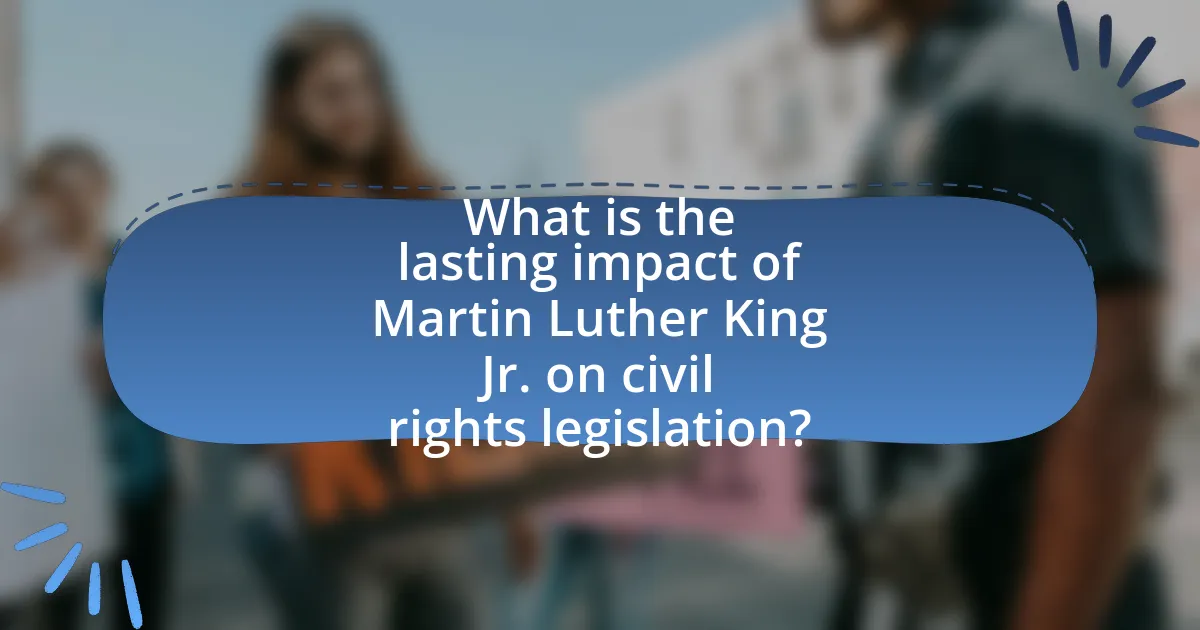
What is the lasting impact of Martin Luther King Jr. on civil rights legislation?
Martin Luther King Jr. significantly influenced civil rights legislation in the United States, primarily through his advocacy for nonviolent protest and his leadership in the Civil Rights Movement. His efforts were pivotal in the passage of landmark laws such as the Civil Rights Act of 1964 and the Voting Rights Act of 1965. These laws aimed to eliminate racial discrimination and protect voting rights for African Americans, fundamentally transforming the legal landscape of civil rights in America. King’s ability to mobilize mass support and articulate the moral imperative for equality helped to create a political environment conducive to these legislative changes.
How do contemporary civil rights movements reflect King’s legacy?
Contemporary civil rights movements reflect Martin Luther King Jr.’s legacy by continuing his fight for racial equality and social justice through nonviolent protest and advocacy. Movements such as Black Lives Matter embody King’s principles by addressing systemic racism and police brutality, echoing his calls for justice and equality as articulated in his “I Have a Dream” speech. Additionally, the emphasis on grassroots organizing and coalition-building in these movements mirrors King’s strategies during the Civil Rights Movement, demonstrating a commitment to collective action and community empowerment. The ongoing struggle for voting rights, highlighted by recent legislative battles, also aligns with King’s efforts to secure equal access to the ballot, reinforcing the relevance of his legacy in contemporary activism.
What modern issues are rooted in King’s fight for equality?
Modern issues rooted in Martin Luther King Jr.’s fight for equality include systemic racism, police brutality, and economic inequality. These issues persist as a result of the historical injustices that King addressed during the Civil Rights Movement, which sought to dismantle segregation and promote equal rights for African Americans. For instance, the Black Lives Matter movement, which emerged in response to police violence against Black individuals, directly reflects King’s legacy of advocating for justice and equality. Additionally, economic disparities, highlighted by statistics showing that Black Americans face higher poverty rates compared to their white counterparts, underscore the ongoing struggle for economic equity that King championed.
How do current leaders draw inspiration from King’s methods?
Current leaders draw inspiration from Martin Luther King Jr.’s methods by employing nonviolent resistance and advocating for social justice. Leaders such as Barack Obama and Kamala Harris have publicly acknowledged the effectiveness of King’s peaceful protests and moral leadership in advancing civil rights. For instance, Obama’s speeches often reflect King’s emphasis on unity and hope, while Harris has highlighted the importance of grassroots activism, echoing King’s belief in collective action for change. This approach is supported by historical evidence showing that nonviolent movements led by King significantly contributed to landmark legislation, such as the Civil Rights Act of 1964 and the Voting Rights Act of 1965, demonstrating the lasting impact of his methods on contemporary leadership strategies.
What lessons can be learned from King’s approach to civil rights advocacy?
King’s approach to civil rights advocacy teaches the importance of nonviolent resistance and the power of collective action. His commitment to nonviolence, exemplified during events like the Montgomery Bus Boycott and the March on Washington, demonstrated that peaceful protests could effectively challenge systemic injustice. Additionally, King’s ability to mobilize diverse groups, including various races and faiths, highlighted the significance of unity in the struggle for civil rights. His strategic use of media to amplify messages of equality and justice further illustrates the impact of communication in advocacy efforts. These lessons remain relevant in contemporary movements for social justice, emphasizing the effectiveness of peaceful protest and coalition-building.
How can activists today apply King’s strategies in their work?
Activists today can apply Martin Luther King Jr.’s strategies by emphasizing nonviolent protest, grassroots organizing, and coalition-building. Nonviolent protest, as demonstrated by King during the Civil Rights Movement, effectively draws attention to injustices while maintaining moral high ground, which can mobilize public support and influence policy change. Grassroots organizing, a method King utilized to empower local communities, enables activists to engage directly with constituents, fostering a sense of ownership and urgency in social justice issues. Coalition-building, exemplified by King’s collaboration with various civil rights organizations, allows for a united front that amplifies voices and resources, increasing the impact of advocacy efforts. These strategies have been validated by historical successes in achieving legislative reforms, such as the Civil Rights Act of 1964, which resulted from sustained activism and public pressure.
What best practices can be derived from King’s legacy for future movements?
Best practices derived from Martin Luther King Jr.’s legacy for future movements include the emphasis on nonviolent protest, the importance of coalition-building, and the necessity of clear, moral messaging. Nonviolent protest, exemplified by King’s leadership during events like the Montgomery Bus Boycott and the Selma to Montgomery marches, has proven effective in garnering public support and media attention while minimizing backlash. Coalition-building, as seen in the formation of the Southern Christian Leadership Conference (SCLC), highlights the power of uniting diverse groups to amplify voices and resources. Additionally, King’s ability to articulate a clear moral vision, as demonstrated in his “I Have a Dream” speech, underscores the significance of inspiring narratives that resonate with a broad audience, fostering empathy and action. These practices have been validated by their successful application in various social movements, including the LGBTQ+ rights movement and environmental activism, demonstrating their relevance and effectiveness in advocating for change.

